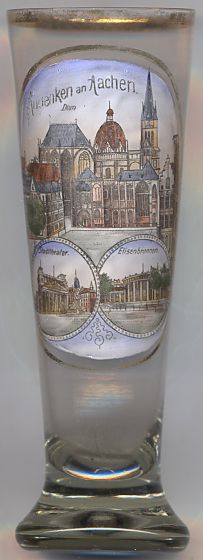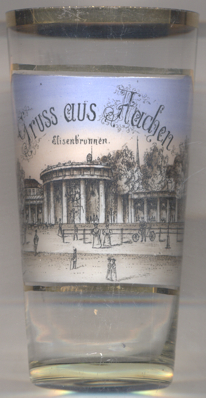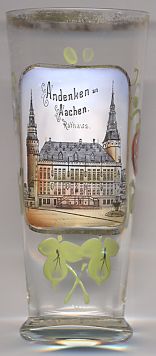

|
| DEUTSCHLAND | GERMANY |
| Bundesland: Nordrhein-Westfalen | North Rhine-Westphalia |
| Regierungsbezirk: Köln | |
| Stadt: Aachen |
Aachen is situated at an elevation of 191 m at the foot of the Eifel low mountain area in the southwest of North Rhine-Westfalia, at the borders to Belgium and the Netherlands. Aachen has a population of about 257,200 (2005). As a spa town, the city is entitled to the predicate Bad, but the name Bad Aachen is only rarely used.
The origin of the town's name is the old Germanic word ahha which means 'water'. Already during the Roman times, this place was known for its hot springs. The Latin name Aquisgranum, that was later used in medieval documents, is derived from the Celtic-Roman god, Grannus. Under the Frankish king Pepin the Younger (Pepin III, 'the Short'), Aachen was first mentioned in a document of 765 AD under the name Aquis villa. The strongly sulfurous waters became the reason that Aachen became an important town under the reign of Charlemagne, Pepin's son. One year after the canonization in 1165 of Charlemagne, Aachen was chartered as a town and obtained the status of a free Imperial city. In 1656 a large fire destroyed more than 4,600 houses, almost the entire old town. After that, the town was rebuilt as one of the most modern spa towns of the period. Aachen was the site of the conclusion of the First Peace of Aachen which in 1668 ended the War of Devolution between France and Spain. The Second Peace of Aachen (1748) ended Austrian War of Succession between Austria and Prussia and also had involved Bavaria, France and Spain. In 1794 French troops occupied Aachen (in French: Aix-la-Chapelle), which became the seat of the administration of the Département de la Roer. After the Congress of Vienna (1815) became part of Prussia as capital of the Province Jülich-Kleve-Berg, in 1824 it was incorporated into the Prussian Rhine province (capital at Koblenz).
After World War I, the western surroundings of Aachen with Eupen became part of Belgium; Aachen itself remained occupied by Belgian troops for eleven years. During World War II about 65% of the town were destroyed. In 1944 the town was evacuated and on 12 October of that year it was the first German town to be taken by the Allied forces. After the war, Aachen was occupied first by American, then British and Belgian troops. In 1946 it became part of North Rhine-Westfalia. The Karlspreis (International Charlemagne Prize of the city of Aachen) was first awarded in 1950 to people who contributed to the European idea and European peace. The population of the municipality Aachen doubled by the incorporation of the neighbouring communities of Brand, Eilendorf, Haaren, Kornelimünster, Laurensberg, Richterich and Walheim following the Aachen-Gesetz (Aachen Act) of 1972.
 The
The  cathedral of Aachen is the popular landmark of the city.
It goes back to the Imperial chapel that was founded by Charlemagne. The central 'Oktogon' was completed in 805 AD.
For four hundred years, the cupola remained the largest construction of its kind north of the Alps. The famous chandelier
was donated by Friedrich I (Barbarossa) in 1165/1170. The impressive Gothic choir (length 25 m, width 13 m,
height 32 m, about 1,000 m² of glass windows) was constructed between 1355 and 1414 to house the famous four
relics of Aachen. The precious feretory of 1220–1239 contains what was believed to be: the diaper and the waistcloth
of Jesus, the dress of the Virgin Mary and the cloth that covered the head of St. John the Baptist after his
decapitation. Since 1239 pilgrimages to this place were known as "Heiligtumsfahrt" or "Aachenfahrt". Since 1349 it is
carried out every seven years. The bell tower at the western side of the octogon was added around 1350.Charlemagne and
Emperor Otto III are buried in the cathedral. The relics of the former are kept in a precious shrine of 1215. Although
the cathedral was not destroyed in World War II it suffered severe damages. The greates loss probably were the historic
glass windows. New, modern, glass windows were installed after the war. In 1978, the cathedral was the first edifice in
Germany that was recognized by UNESCO as a World Heritage site (see also list of other UNESCO
heritage sites).
cathedral of Aachen is the popular landmark of the city.
It goes back to the Imperial chapel that was founded by Charlemagne. The central 'Oktogon' was completed in 805 AD.
For four hundred years, the cupola remained the largest construction of its kind north of the Alps. The famous chandelier
was donated by Friedrich I (Barbarossa) in 1165/1170. The impressive Gothic choir (length 25 m, width 13 m,
height 32 m, about 1,000 m² of glass windows) was constructed between 1355 and 1414 to house the famous four
relics of Aachen. The precious feretory of 1220–1239 contains what was believed to be: the diaper and the waistcloth
of Jesus, the dress of the Virgin Mary and the cloth that covered the head of St. John the Baptist after his
decapitation. Since 1239 pilgrimages to this place were known as "Heiligtumsfahrt" or "Aachenfahrt". Since 1349 it is
carried out every seven years. The bell tower at the western side of the octogon was added around 1350.Charlemagne and
Emperor Otto III are buried in the cathedral. The relics of the former are kept in a precious shrine of 1215. Although
the cathedral was not destroyed in World War II it suffered severe damages. The greates loss probably were the historic
glass windows. New, modern, glass windows were installed after the war. In 1978, the cathedral was the first edifice in
Germany that was recognized by UNESCO as a World Heritage site (see also list of other UNESCO
heritage sites).
In 813, Charlemagne's son, Ludwig 'the Pious', was crowned here as co-regent. Lothar I, grandson of Charlemagne, crowned himself emperor here. The church also was the site of the coronation of Otto I as East Frankish king (936 AD). Since then, it remained the site of the coronation of the German kings. Thirty-one kings were crowned in the church, the last being Ferdinand I in 1531.
The first bishopric of Aachen was founded in 1802 by Napoléon I. It consisted of those parts of the former archdiocese of Cologne located left of the Rhine, parts of the diocese Liège and small parts of the dioceses Utrecht, Roermond and Mainz. In 1821 the diocese was dissolved and re-incorporated into the archdiocese of Cologne. The present diocese of Aachen was founded in 1930.
The  Stadttheater (Municipal Theatre) [bottom left picture) was built in
1900–1901 by Heinrich Seeling. It replaced the old municipal theatre that had been built in 1823–1825 by
Johann-Peter Cremer and Karl Friedrich Schinkel. The new theatre had a capacity of 1,014 seats. The building was destroyed
by fire after bombings on 14 July 1943. The theatre was restored in 1948–1951 without the two front towers and with a
modern auditorium. Today, the theatre has a capacity of 905 seats.
Stadttheater (Municipal Theatre) [bottom left picture) was built in
1900–1901 by Heinrich Seeling. It replaced the old municipal theatre that had been built in 1823–1825 by
Johann-Peter Cremer and Karl Friedrich Schinkel. The new theatre had a capacity of 1,014 seats. The building was destroyed
by fire after bombings on 14 July 1943. The theatre was restored in 1948–1951 without the two front towers and with a
modern auditorium. Today, the theatre has a capacity of 905 seats.
 The
The  Elisenbrunnen [near left, no. 3545, and far left, no. 2109: bottom
right picture] was built in 1825–1827 in Classicist style by Karl Friedrich Schinkel. The pump room houses
the 'Kaiserquelle' (emperor's spring), which supplies hot (74°C) sulfurous waters. In World War II the building
was almost completely destroyed and was re-opened after its reconstruction in 1953.
Elisenbrunnen [near left, no. 3545, and far left, no. 2109: bottom
right picture] was built in 1825–1827 in Classicist style by Karl Friedrich Schinkel. The pump room houses
the 'Kaiserquelle' (emperor's spring), which supplies hot (74°C) sulfurous waters. In World War II the building
was almost completely destroyed and was re-opened after its reconstruction in 1953.

The  town hall [near left, no. 2181] was built on the site of the
Karolingian imperial residence. The first, Gothic, town hall was built in 1330–1349. In the 17th and 18th century it
was remodeled in Baroque style. In the 19th century many of the Baroque additions were removed and replaced by neo-Gothic
details. The main faç was ornated with 50 sculptures of German kings. Following a large fire, which destroyed the
roofs in 1883, the town hall was restored until 1902. The lower parts of the eastern tower of the town hall (Granusturm
[not depicted on glass no. 2181]) date from around 770 and are the only remainig part of the
Karolingian residence. The Granusturm thus is the oldest building of Aachen. During World War II the building suffered
heavy damages but was restored again after the war. Copies of the Imperial Regalia, the originals of which are in
Vienna, are exhibited in the town hall as a reminder to the 31 coronations of German kings that
took place in Aachen. The town hall is the site of the annual award ceremony of the International Charlemagne Prize of the
city of Aachen.
town hall [near left, no. 2181] was built on the site of the
Karolingian imperial residence. The first, Gothic, town hall was built in 1330–1349. In the 17th and 18th century it
was remodeled in Baroque style. In the 19th century many of the Baroque additions were removed and replaced by neo-Gothic
details. The main faç was ornated with 50 sculptures of German kings. Following a large fire, which destroyed the
roofs in 1883, the town hall was restored until 1902. The lower parts of the eastern tower of the town hall (Granusturm
[not depicted on glass no. 2181]) date from around 770 and are the only remainig part of the
Karolingian residence. The Granusturm thus is the oldest building of Aachen. During World War II the building suffered
heavy damages but was restored again after the war. Copies of the Imperial Regalia, the originals of which are in
Vienna, are exhibited in the town hall as a reminder to the 31 coronations of German kings that
took place in Aachen. The town hall is the site of the annual award ceremony of the International Charlemagne Prize of the
city of Aachen.
![[scale]](lineal.jpg)